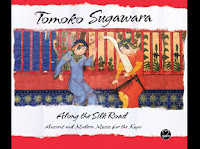In review--Vistas from the Silk Road
Along the Silk Road
Ancient and Modern Music for the Kugo
Motema
I normally wouldn’t expect a delicate Silk Road recording to be released on a jazz label. However, Japanese harpist Tomoko Sugawara debuts on Motema’s New World series with her exquisite recording, Along the Silk Road. Although this album marks her third recording, I believe it’s her first recording featuring the kugo, a harp that finds its roots in ancient Mesopotamia. Also known as an angular harp, “chang” (Iran) and “kunghou,” the instrument traveled on the Silk Road from the Middle East and Spain to China and Japan. Then it mysteriously disappeared during the 17th century.
On Along the Silk Road, Sugawara performs solo pieces in which the harp resembles a Japanese zither (koto) as she plucks the tight strings with an occasional strum for emphasis. She also performs collaborative pieces, such as Qawl (ancient Iran), which features a duet of kugo and the Middle Eastern hand drum darabuka, Shakugo I with alto flute and the cantigas for Saint Mary from medieval Spain, in which the harp joins a darabuka and a bendir (frame drum).
I’m amazed at the depth of emotions Sugawara draws from her harp, as well as, the many styles she performs here from Japanese, ancient Chinese, Iranian (both contemporary and ancient) and medieval Spain. She performs commissioned work by Kikuko Masumoto, Stephen Dydo’s adaptations of ancient Tang Dynasty manuscripts, Robert Lombardo and Amir Mahyar Tafreshipour. And she’s joined by Robert Dicks (alto flute) and Ozan Aksoy (bendir and darabuka).
The recording goes beyond providing gentle and meditative music. I’m listening to the disk the third time while I write this review and the music helps me to stay focused. I listened to the disk before going to bed last night and I found the music helped me fall into a deep sleep. While Sugawara performs music worth careful listens, it would also bode well with energy and massage work. Even with the percussion that appears on 3 of the 13 tracks, the overall feeling could be compared to sinking into a hot tub of water and relaxing fragrances.
And who doesn’t enjoy traveling down the Silk Road musically speaking? Along the Silk Road provides beautiful music and a musical history lesson that spans from ancient times to the 17th century and then celebrates a resurgence of the angular harp.
Motema




Comments
Post a Comment